Je hebt misschien gehoord dat katten negen levens hebben. Nou, misschien is dat waar, maar één ding is zeker:je kat kan een lang en gezond leven hebben met de juiste zorg. Er zijn veel dingen waarmee u rekening moet houden bij het verzorgen van een kat, en we zullen ze allemaal behandelen in de volgende secties:
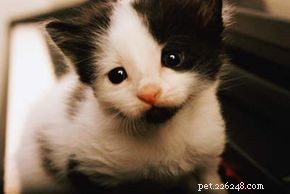
Voordat je echt een kat koopt, moet je bedenken wat voor soort kat je wilt:kitten of volwassen kat; langhaar of korthaar; rasechte of straatkat; man of vrouw; tabby, patched of effen kleur.
Als je je hart hebt gericht op een bepaalde maat, leeftijd, geslacht, ras of uiterlijk van de kat, doe dan wat extra onderzoek voordat je op zoek gaat naar een kat. Het zal je misschien verbazen dat de look waar je van houdt niet goed past bij je levensstijl. Als je bijvoorbeeld van een rustig huis houdt, is een Siamees misschien niet de kat voor jou:het zijn beruchte 'praters'. Evenzo is een Perzische kat prachtig om naar te kijken, maar tenzij je vastbesloten bent om bijna dagelijkse verzorging te doen (of een professional te betalen om het elke week of zo te doen), is een mooie kortharige kat misschien een beter idee. Reis je veel? Dan heb je een meer volwassen kat nodig - minstens acht maanden of ouder. Twee katten zijn nog beter, zodat ze elkaar gezelschap kunnen houden terwijl jij weg bent.
Iedereen houdt van kittens. Ze zijn schattig, grappig en knuffelig - daar bestaat geen twijfel over. Maar maak niet de fout dat het 'baby's' zijn. Tegen de tijd dat een kitten klaar is om weg te zijn van zijn moeder en bij u in huis te wonen, kan hij lopen, rennen, springen en klimmen als het kattenequivalent van een tienjarig kind. Bovendien, als je vandaag een kitten krijgt, heb je in slechts een paar maanden tijd een volwassen kat -- een kat die gemiddeld 12 tot 15 jaar zal leven.
Als je de tijd, het milieu en de energie hebt om een kitten groot te brengen, doe het dan vooral -- het is een geweldige ervaring. Vergeet niet dat kittens veel onderhoud vergen. Ze vragen veel aandacht. Ze hebben routinematige veterinaire zorg nodig, bestaande uit boostershots, ontworming en sterilisatie of castratie. Bijna alle jonge kittens beginnen aanhankelijk en passief, maar ze hebben wat socialisatie en training nodig om zo te blijven; en zelfs dan weet je pas hoe hun volwassen persoonlijkheid eruit zal zien als ze volwassen zijn.
Ten slotte gaan zeer jonge kinderen en zeer jonge kittens meestal niet goed samen. Het is leuk om te bedenken dat een peuter en een katje van tien weken 'samen kunnen opgroeien', maar zo gebeurt het echt niet. Over zes maanden zal dat kleine bolletje pels dat uw kind zou kunnen ronddragen uitgegroeid zijn tot een volwassen kat van meer dan tien pond, en uw driejarige zal... drie en een half jaar oud zijn!
Er is zeker geen gevaar voor een kattentekort in deze Verenigde Staten - er zijn genoeg katten om rond te lopen en nog wat. In de meeste delen van het land zou je bij zonsopgang gewoon je voordeur kunnen openen, en er zou waarschijnlijk een kat binnenlopen voordat je klaar bent met ontbijten.
Het aantal katten in de buurt brengt je zelfs in een soort dilemma. Hoe kies je de juiste? Zal het gezond zijn? Hoe zit het met verborgen gezondheids- of gedragsproblemen? Wat gebeurt er met de kat als het bij jou thuis niet lukt?
Een kat krijgen is niet hetzelfde als een grasmaaier of een föhn krijgen; ze komen niet met garanties. Elke kat zal anders zijn, wat betekent dat elke kat unieke geneugten en problemen heeft. Toch zouden bronnen voor katten u moeten helpen een beslissing te nemen. Hoewel de bron niet kan beloven dat de kat nooit ziek zal worden, kunnen ze stappen ondernemen om de kat de best mogelijke kansen te geven om gezond te blijven. Goede bronnen voor het vinden van de juiste kat voor u zijn:
Vrienden en buren. De kans is groot dat iemand die je kent een kat of kittens heeft die een thuis nodig hebben. Vaak werkt het voor iedereen het beste om een kat van een buur of vriend te nemen, vooral als het een kitten is uit het kattenbakvulling van je buren of het huisdier van een allergische vriend. Je persoonlijke relatie met deze bron betekent meestal dat je ook het eerlijke verhaal over deze specifieke kat krijgt. Een paar waarschuwingen over het krijgen van je kat van een vriend of buurman:verwacht niet dat de kat de uitgebreide veterinaire zorg krijgt die een kat uit een asiel of fokker heeft, en wees voorzichtig met het mengen van zaken en vriendschap.
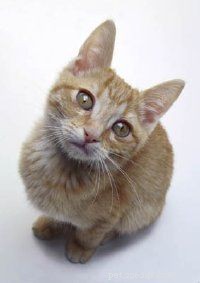
Dierenopvang. Miljoenen dakloze katten worden elk jaar geëuthanaseerd in dierenasielen. Adoptie uit een asiel redt een leven, maakt ruimte voor een andere kat en is een goedkope manier om een huisdier te krijgen met goedkope inentingen en castratie. Wees voorbereid op sollicitaties en interviews, waarvan sommige misschien een beetje te persoonlijk en opdringerig lijken. Vat het niet persoonlijk op - ze hebben er goede redenen voor. Zorg er ook voor dat u de faciliteiten en de staat van de adopteerbare huisdieren controleert. Omdat de dieren in nauw gezelschap leven, kunnen ziektes, wormen en vlooien een probleem zijn. Pet Finders (www.petfinder.org) houdt een database bij van katten die beschikbaar zijn voor adoptie bij plaatselijke opvangcentra.
Kwekers. Als je een rasechte kat wilt, is dit de juiste keuze. Goede fokkers hebben veel kennis van katten in het algemeen en hun ras in het bijzonder en zijn voorzichtig met aan wie ze hun katten verkopen. Pas op voor "koopjes" raszuivere dieren en "kelderfokkers" (mensen die uitsluitend fokken voor winst). Een gerenommeerde fokker is geïnteresseerd in het onderhouden van een dier van hoge kwaliteit, houdt een zorgvuldige administratie bij en produceert meestal slechts één of twee nesten per fokdier per jaar. Vraag om een verwijzing van een fokker van nationale rasverenigingen zoals de Cat Fanciers' Association (www.cfa.org).
Zwerfkatten. Soms hoef je je geen zorgen te maken over het vinden van de juiste kat, de juiste kat vindt jou. Veel mensen zweren dat dit de beste katten zijn om te hebben. Er zijn geen adoptie-interviews of kosten als je een zwerfdier opneemt, en meer dan waarschijnlijk red je een leven. Aan de andere kant moet je de kosten van injecties, ontworming, castratie en dergelijke betalen. Veel zwerfdieren hebben andere gezondheidsproblemen die misschien niet meteen opduiken en die duur kunnen worden om te behandelen. Soms kunnen lokale, humane verenigingen helpen met de eerste zorg van de dierenarts, of een dierenziekenhuis in de omgeving kan verlaagde tarieven aanbieden voor de behandeling van een vondeling, maar reken er niet op.
Een andere belangrijke beslissing die u moet nemen bij het kiezen van een kat, is of u een binnenkat of een buitenkat wilt hebben. Lees meer over de gevolgen van elke beslissing in het volgende gedeelte.
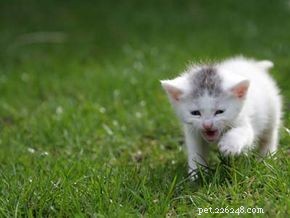
Misschien is niets zo zielig als het gejammer van een kat die aan de andere kant van een deur wil zijn. Als het de voordeur is, denken velen van ons dat onze katten niet echt gelukkig zullen zijn tenzij ze naar buiten gaan. Maar nogmaals, de meeste katten maken hetzelfde soort kabaal als ze naar binnen willen (of, wat dat betreft, wanneer ze door een deur willen). Willen katten echt naar buiten? Moeten ze dat? En zelfs als het antwoord op beide vragen 'ja' is, is dat dan echt in hun belang?
Moeten katten naar buiten als honden?
De belangrijkste reden waarom honden worden uitgelaten, is eliminatie, op de voet gevolgd door oefening. Alleen de kleinste honden kunnen binnen genoeg rennen. Honden zijn roedeljagers, wat betekent dat ze samenwerken om hun prooi uit te putten. Dat kan de hele dag duren, wat betekent dat honden een natuurlijk instinct hebben om te rennen... en rennen... en rennen. Voor dat soort werk heb je veel open ruimte nodig. Katten daarentegen zijn 'hinderlaagjagers'. Ze vertrouwen op relatief korte uitbarstingen van zeer snel rennen. Een gang van enige behoorlijke lengte biedt daarvoor voldoende ruimte. Dat in combinatie met het instinct om afval te begraven (daarom gebruiken katten een kattenbak), is er geen dringende reden om een kat mee naar buiten te nemen.
Natuurlijk zijn frisse lucht en zonneschijn goed voor iedereen - mens of kat. Maar is het buitenleven echt "natuurlijker" voor uw kat? Natuurlijk, zijn wilde voorouders leefden buiten. Maar dat was een paar duizend jaar en een paar honderd generaties geleden. Als klap op de vuurpijl leefden die voorouders in de droge streken van het Midden-Oosten - ver verwijderd van het klimaat en de omgeving van de Verenigde Staten van vandaag. Toen katten eenmaal gedomesticeerd waren, stopten ze met volledig "natuurlijk" te zijn; toen ze eenmaal uit hun oorspronkelijke habitat waren ontworteld, moesten ze hun best doen om hun instincten die gedurende tienduizenden jaren in de woestijnen van het Midden-Oosten waren aangescherpt, aan te passen aan hun nieuwe omstandigheden. Sommige van die omstandigheden -- de bittere kou van een winter in het Midwesten, honden en wilde dieren die hen van jager in gejaagde zullen veranderen, en snel rijdende auto's en vrachtwagens, om er maar een paar te noemen -- kunnen ze zich nooit echt aan aanpassen.
Wat wacht uw kat net buiten uw voordeur? Ja, er zijn bomen en gras en alle bezienswaardigheden, geluiden, geuren en geneugten van de natuur -- goede dingen waar we allemaal van kunnen genieten. Maar er zijn ook wrede dieren, wrede mensen, verkeers-, ziekte- en dierencontrolebeambten (die mogelijk binnen hun wettelijke recht vallen om uw kat te grijpen en in beslag te nemen als hij van uw eigendom stapt). De enige betrouwbare manier om uw kat te beschermen tegen al deze dodelijke gevaren, is door hem binnen te houden.
Eerlijk gezegd zijn plattelandskatten niet per se veiliger buitenshuis dan stadskatten. Natuurlijk, er is veel meer kans om door een auto te worden aangereden of verscheurd door een zwerfhond in de stad. Maar in het land hebben we roofdieren die groter, sneller en slimmer rennen dan een verwilderde stadshond. We hebben ook minder licht op de wegen, waardoor zwerfdieren moeilijker te zien zijn - en gemakkelijker te raken - en meestal meer soorten ziekteverwekkende insecten, zoals teken.
Een hele reeks ernstige en dodelijke kattenziekten hebben contact nodig met geïnfecteerde katten - of gebieden waar geïnfecteerde katten veel rondhangen - om zich te verspreiden. Feline Immunodeficiency Virus (FIV), dat een afbraak veroorzaakt in het ziektebestrijdende immuunsysteem van de kat, wordt meestal overgedragen door beten van geïnfecteerde katten. En het kattenleukemievirus (FeLV) vereist over het algemeen langdurig nauw contact met een geïnfecteerde kat, zoals het delen van kattenbakken of voedsel- en waterbakken of wederzijdse verzorging. Keer op keer zijn de risico's op ziekte gering of verwaarloosbaar voor binnenkatten, aanzienlijk hoger voor buiten- of binnen-/buitenkatten. Kattenbezitters - vooral die met jonge kinderen - moeten zich er in het bijzonder van bewust zijn dat buitenkatten meer kans hebben om ziekten en parasieten op te pikken die mensen kunnen treffen, van kleine ergernissen zoals vlooien tot ernstigere ziekten zoals de tekenziekte van Lyme tot extreem gevaarlijke omstandigheden zoals hondsdolheid.
Alleen omdat het voor uw kat het veiligst is om binnen te leven en niet vrij rond te lopen, wil nog niet zeggen dat hij nooit het daglicht kan zien behalve door het raam. Een riem en harnas (geen halsband) is een redelijk veilige manier voor zowel u als uw kat om wat frisse lucht en zonneschijn te krijgen. Aan de lijn lopen is een verworven smaak die sommige katten echter nooit zullen verwerven. Regelmatige ervaring van kittentijd helpt, en sommige aan de lijn getrainde katten zullen zelfs om een wandeling vragen. Natuurlijk loopt een kat aan de leiband nog steeds risico om vlooien op te pikken - en voor ontmoetingen met losgelaten katten en honden in de buurt.
Het bouwen van een kattenren is eigenlijk niet zo moeilijk als het klinkt. Lopen moeten aan alle zijden (inclusief de bovenkant) zijn ingesloten en stevig verankerd en gebouwd. Schermen moeten van de zwaarste kwaliteit buitengaas zijn en muren moeten enkele centimeters onder de grond uitsteken om te voorkomen dat katten zich een weg naar buiten kunnen graven - of andere dieren zich een weg naar binnen kunnen graven. Als de ren niet aan uw huis is bevestigd met een huisdierluik of een andere deur die naar binnen leidt, zorg er dan voor dat er een soort verwarmd, waterdicht onderkomen is waar uw kat zich in kan terugtrekken in geval van slecht weer.
Het is vooral belangrijk voor een ren of andere buitenomheining om een dak te hebben. Katten zijn geweldige klimmers en springers, en zelfs een acht tot drie meter hoge muur houdt ze misschien niet tegen, vooral als er schermen zijn om aan vast te haken. Het dak en de muren van de ren bieden ook nog een ander soort veiligheid:ze houden andere dingen buiten. Openingen in het dak of de muren laten onvriendelijke of gevaarlijke dieren, mensen en dingen toe in een gebied waar uw kat misschien niet kan ontsnappen.
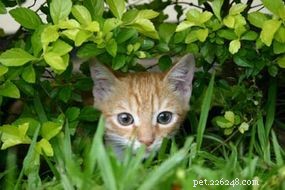
Vrij rondlopende katten krijgen 's avonds laat ruzie met andere katten, kauwen of graven planten van buren op, doden lokale vogels (maar kunnen ook helpen de lokale knaagdierpopulatie onder controle te houden) en begraven hun afval in de tuinen van andere mensen. Terwijl sommige mensen - en sommige kattenbezitters - dit als kleine ergernissen zien, zien veel andere mensen ze als veel serieuzere problemen. Als je kat ruzie krijgt, kan hij meer doen dan de buren wakker maken vanwege het gejank en geschreeuw. De oppervlakkige krassen die je op zijn gezicht of rug ziet, zijn niet zo erg. Maar hij kan ook bijtwonden hebben die snel sluiten, vuil en ziektekiemen insluiten en enkele dagen later een pijnlijk abces veroorzaken. Beten tijdens gevechten lijken ook de belangrijkste manier te zijn om het kattenimmunodeficiëntievirus te verspreiden. Ongewijzigde katten die vrij rondlopen, dragen ook bij aan de overbevolking van huisdieren, een probleem dat de dierenasielen tot aan de nok toe vult, wat ertoe leidt dat miljoenen honden en katten elk jaar "in slaap worden gebracht".
Nu je de perfecte kat voor je hebt gekozen, is het tijd om te leren hoe je voor hem moet zorgen. We beginnen in het volgende gedeelte met tips voor het voeren van uw kat.
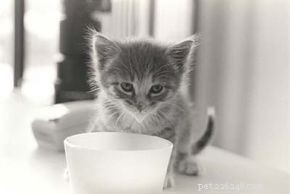
"Je bent wat je eet" is een solide stuk gezond verstand dat net zo waar is voor je kat als voor jou. Als u uw kat een kwaliteitsdieet geeft, is de kans groter dat u een gezonde kat krijgt.
De huisdiervoedingsindustrie is big business - en met goede reden. Er leven meer dan 100 miljoen honden en katten in Amerikaanse huizen, plus wie-weet-hoeveel meer in opvangcentra, cattery's en kennels in het hele land. Als klap op de vuurpijl heb je duizenden mensen die zwerfdieren voeren. Als je denkt dat een enkele kat in een jaar ongeveer 90 pond of meer aan kattenvoer kan verwerken, hebben we het over honderden miljoenen dollars die jaarlijks worden uitgegeven, alleen maar om de kat te voeden.
Net als voedsel voor mensen, zijn er enkele smakelijke kattensnoepjes die goed zijn voor katten en sommige dingen die in feite junkfood zijn. Af en toe een snack van de niet-zo-gezonde dingen mag geen blijvende schade aanrichten, maar maak het geen vast onderdeel van het dieet van uw kat.
De wilde voorouders van de moderne huiskat waren jagers - een instinct dat uw kat nog steeds heeft. Of Tabby nu geschenken brengt van overleden vogels en muizen of zich op een stuk pluis stort, ze geeft uitdrukking aan een krachtige natuurlijke drang om prooien te besluipen en te doden. Als je twijfelt of je kat een van nature geboren vleeseter (en roofdier) is, kijk dan eens goed naar haar tanden als ze de volgende keer gaapt. Die hoektanden zijn niet ontworpen om alfalfaspruiten te eten.
Het feit is dat uw kat zo'n vleeseter is, dat ze niet kan overleven als vegetariër. Er zijn bepaalde voedingsstoffen die alleen in dierlijke eiwitten voorkomen die uw kat nodig heeft. Een van deze voedingsstoffen is een aminozuur dat taurine wordt genoemd. Zonder taurine kunnen katten blind worden en vergrote harten ontwikkelen, die ze waarschijnlijk ruim voor hun tijd zullen begeven. En in tegenstelling tot honden hebben katten een voedingsbron nodig van vitamine A en een vetzuur dat arachidonzuur wordt genoemd en dat alleen in dierlijk weefsel voorkomt. Geef daarom nooit hondenvoer aan uw kat. Hondenvoer heeft gewoon niet genoeg van de juiste soorten voedingsstoffen voor katten. Per pond kan het goedkoper zijn om hondenvoer aan uw kat te geven, maar het kan uw kat haar gezondheid, zicht of zelfs haar leven kosten.
Dat betekent natuurlijk niet dat u uw kat rauw vlees moet voeren of haar moet laten afhangen van de jacht als haar enige voedselbron. Het is honderden jaren geleden dat katten in het wild leefden, dus hun jachtvaardigheden zijn meer dan een beetje roestig. Bovendien kunnen katten die op rauw of onvoldoende verhit vlees jagen of eten, verschillende soorten ziekten oplopen, waaronder sommige die aan u kunnen worden doorgegeven.
Als het groen is en uit de grond groeit, is de kans groot dat een kat het zal proberen op te eten. Deze vegetarische gril in de persoonlijkheid van de vleesetende kat is vooral zorgwekkend als de planten in kwestie je gewaardeerde kamerplanten zijn - of erger nog, als ze giftig zijn voor je kat.
Veel kattenbezitters beschouwen het eten van planten als een gedragsprobleem - en als de kat planten eet, wil je niet dat ze dat doet. Sommige mensen gaan ervan uit dat een kat die planten eet, niet genoeg krijgt van de juiste soorten voedsel in haar dieet. Ze hebben ook gelijk -- maar alleen in die zin dat wat de kat meer nodig heeft in haar dieet... planten zijn.
De experts hebben een paar ideeën waarom katten planten eten. Het kan zijn om sporen van voedingsstoffen binnen te krijgen, om te helpen bij de spijsvertering, of als een braakmiddel om ingeslikt haar en andere non-food items te helpen opvoeden. Wat de reden ook is, het eten van vegetatie is een instinctief gedrag bij katten; je kunt het niet stoppen. Dus het beste is om het gedrag in een richting te sturen waar jullie allebei mee kunnen leven.
Plan een 'kattentuin'. Je kunt kant-en-klare kits vinden in dierenwinkels en catalogi, maar een voordeligere keuze is om het gewoon zelf te doen. Als je handig bent, kun je een mooie container van hout bouwen of je kunt gewoon iets bij de hand gebruiken. Wat je ook doet, zorg ervoor dat je je kattentuin plant in een bak die niet kantelt of gemakkelijk beweegt. Het enige wat je nodig hebt is een paar centimeter goede potgrond en wat zaden. Havergras of kattenkruid zijn goede keuzes. Misschien wil je de tuin buiten het bereik van je katten houden terwijl je "gewas" in opkomst is, maar zodra de greens een paar centimeter lang zijn, zet je hem uit en laat je Tabby naar believen kauwen.
Haal uw planten buiten bereik. Katten zijn ongelooflijk goede klimmers en springers, dus het zal waarschijnlijk niet veel helpen om je kamerplanten op standaards of planken te zetten. Mantels, vensterbanken en dergelijke zijn gemakkelijke landingsplaatsen voor katachtige acrobaten. Hang planten aan het plafond, plaats ze achter katveilige barrières (bijvoorbeeld op een veranda die is afgesloten met glazen deuren), of zet ze op locaties waar je kat absoluut niet kan springen, klimmen of kruipen.
Bescherm je planten. Als je je planten niet buiten het bereik van katten kunt krijgen, probeer dan een beschermend schild rond je planten te vormen. Het plaatsen van kippengaas, plantmarkeringen of zelfs mottenballen in de grond rond uw plant kan hem beschermen tegen nieuwsgierige poten, maar deze barrières zijn niet zo mooi om naar te kijken. Probeer wat Spaans mos rond de basis van je plant toe te voegen om je kat weg te houden. Soms zal het sproeien van bitters op de bladeren een kat ontmoedigen om te kauwen. Andere keren echter, doet het aanbrengen van een slecht smakende substantie op een plant meer schade aan de plant dan aan de tanden van de kat.
Een goed gevoede kat hoeft niet meer tussen de maaltijden door te snacken dan jij. Te vaak tussendoortjes hebben hetzelfde effect op uw kat als op u:ongezonde gewichtstoename en een onevenwichtige voeding.
Natuurlijk is het moeilijk om de verleiding te weerstaan om je kattenvriend af en toe een traktatie te geven - en het is prima om aan die verleiding toe te geven, ervan uitgaande dat er een voldoende lange tijd tussen nu en dan is. Hoe lang hangt af van uw kat en het soort traktaties dat u haar geeft. Als uw kat nog steeds elke dag de aanbevolen hoeveelheid kwaliteitsvoer voor katten eet en niet te zwaar is, dan geeft u haar waarschijnlijk niet te veel traktaties. Als uw kat daarentegen eet smakelijke maar niet zo voedzame snacks en ofwel voller wordt of haar neus ophaalt tijdens het avondeten, is het tijd om uw strategie te veranderen.
In de winkel gekochte kattensnoepjes zitten meestal niet boordevol goede voeding. Hun belangrijkste doel is hetzelfde als menselijke lekkernijen:om goed te smaken - echt goed - en dat is het dan ook. "Gourmet" cat snacks usually have fewer artificial colors and fillers in them but still aren't meant to be fed as a regular part of Tabby's diet. The good thing about "gourmet" treats is the cost:They're usually so expensive that cat owners won't overfeed them to their cats!
A question vets hear all the time is, "Can I feed my cat people food?" There's very little that people eat that cats shouldn't (or won't), so that's not really so much of a problem. (Cat owners should be careful about feeding dairy products to their pets. Although cats love dairy products, many don't digest them well and may get sick.) The question once again is nutritional balance. Just like with home cooking, feeding your cat leftovers or using people food for snacks may not be providing her with the right nutrients in the right amounts.
Still, people food might provide some of the healthiest snacks for cats. If you give your cat some scrambled eggs or a couple of pieces of pasta, at least you know what's in it. And you might be surprised what your cat will eat. Cat owners report their pets begging for predictable tidbits such as fish and chicken as well as unexpected ones, including tomatoes and cantaloupe.
Your cat needs about an ounce of water per pound of body weight every day. That doesn't sound like much, but it adds up:An average-size cat would need two quarts of water every week.
Of course, cats get water by drinking. But there's another important source of water for your cat:the food she eats. The more water there is in her food, the less she needs to drink. Canned cat food is more expensive because you're buying water along with the food (up to 75 percent of wet cat food is water) and paying a little more for the container. Dry cat food has much less water (perhaps 10 percent by weight), which means a cat whose diet consists of only dry food has to drink a lot more.
Dehydration (not enough water in the body) is a serious problem for any living creature, and cats are especially prone to it. A cat can go without food for days, losing up to 40 percent of her body weight, and still survive. But a loss of body water of only 10 to 15 percent can kill her. Other liquids -- like milk, if it doesn't make your cat sick -- are a good source of water, but nothing beats the real thing. Be sure your cat has plenty of clean, fresh water available at all times.
We will conclude our examination of cat food with a discussion of store-bought cat food vs. homemade cat foods in the next section.
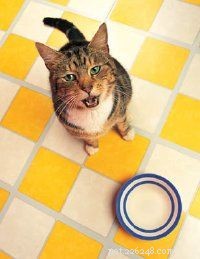
The best thing about a home-cooked meal is you're the one who gets to decide what's in it. If you're a steak-and-potatoes type, then you'll broil up a nice lean Porterhouse and a batch of new reds. On the other hand, if you go for a green salad, you can pick your dinner fresh from the garden. Trying to cut down on cholesterol and salt? When you're the cook, you make the call.
Unless you are a nutritionist or dietitian, however, you should let the experts -- the major pet food manufacturers -- prepare the major portion of kitty's diet. Working out the right amounts and balance of foods is a difficult task. Most food can get lumped into one or more of three categories of nutrition:protein, fat, and carbohydrate. Different kinds of animals (including people) need different proportions of protein, fat, and carbohydrate in their diets. (That's another reason why dog food isn't good for cats -- dogs and cats need different percentages of fat and protein to stay healthy.) What's more, those needs change during an animal's life. A kitten has different nutritional needs than an adult cat, and they both have different needs than an old codger cat. Most pet food companies have special formulas for different levels of age and activity, and there's a whole line of prescription diets for cats with various health problems.
We've all seen a cat come running at the sound of a can opener -- there's no doubt that kitty loves getting canned food. But is canned food better for cats than dry food? Not necessarily. Each type of food has its advantages and disadvantages. The most important factor is whether the food meets your cat's nutritional needs. Of course, your budget and your cat's preference also play a role in which type of food you should choose. Store-bought cat food comes in three general forms:
Each of these types of foods has its strong points and weak points. For instance, dry food is convenient, economical, and can be left out all day. On the other hand, the way some dry foods are formulated seems to encourage the formation of bladder stones. The rich aromas of canned food will tempt even the most finicky eater, but the crunchiness of dry food helps prevent dental plaque. Semimoist combines the convenience of dry food with the tastiness of canned food but may contain the most nonfood fillers and dyes.All brand-name cat food covers the basic nutritional needs of your average cat. But if you're worried about the overall quality of the boxes, bags, and cans of feline food in the pet supplies aisle of your local market, you might want to consider one of the premium-brand foods, usually found only in pet stores or through veterinarians. Feeding your cat store-bought food ensures that she is getting the nutrients she needs. At the same time, a home-cooked supplement to your cat's regular diet is okay if you make sure the foods you select are appropriate for cats. There's nothing wrong with getting the most out of a whole fryer by cooking up the gizzards for the cat, unless they become the major part of Tabby's diet. You see, organ meats (kidney, stomach, and even liver) are all right for your cat in moderation, but they've been linked to health problems if your cat eats too much of them. Likewise, every cat on the planet loves milk and cheese, but most cats have trouble digesting them well.In the next section, we will cover another very important aspect of cat ownership -- grooming.
What's In Cat Food?Careful consumers are label readers -- and that's a good place to start in figuring out just what you're feeding your cat when you buy cat food.Many pet owners compare the nutrition information on different brands of pet food and notice that a less-expensive brand has the same nutrients as a premium cat food. What that really means is that those two foods match up in the laboratory. For example, old shoe leather might rate as high as lean chicken breasts in protein content; of course, you and your cat would both rather eat chicken. So, what you need to know is how the various nutrients match up in your cat.You see, it's not how much of a particular nutrient there is in a can of cat food that matters but how much your cat's digestive system can take up. Cheap foods are usually made from cheap ingredients, which your cat may not digest well. Just because your cat gobbles it up and yowls for more doesn't mean a food is good for her. (Think about kids and junk food.)
The moral of the story is brand-name and specialty pet foods are made by companies that do a lot of research into pet nutrition. They're always improving their foods to keep pace with the latest information, and they use quality ingredients that have nutrients your cat can use. It may cost a little more, but it's worth it.
Lees verder
Ever wonder why some cats always look sleek and beautiful and others look like...well, like something the cat dragged in? While it's true that some cats (like some people) are just born with "good hair," a lot of it has to do with grooming. Now, cats are fastidious critters. They tend to take care of themselves pretty well, always licking their fur to keep it clean and in its proper place. But any cat can go from Fluffy to Scruffy without a little help from her human pals.
The magnificent coat of a champion Persian is truly a work of art. But you'd better believe that it took hours of regular grooming to get it -- and keep it -- that way. It's common sense that the more hair there is to take care of, the more work that goes into it. The fluffier the cat's hair, the more likely it is to form mats, too. These thick tangles of hair can be painful and even tear a cat's skin if the mats get bad enough. Mats get embarrassing for a cat, too, since the only way to get rid of really bad ones is to shave them off. Nothing looks more uncomfortable than a cat who has been shaved.
It's not that shorthair cats don't need regular grooming or never get mats -- they do. It's just that their shorter, coarser outer coat requires lower maintenance than a long, silky coat. A shorthair cat who's diligent about her own grooming routine can do a lot to make up for an owner who's a little lazy with the brush and comb. But regular grooming is still a must for both longhair and shorthair cats.
Cats use their tongue and teeth for grooming. Every time Tabby goes into her contortionist bathing routine, she's swallowing hair. The more hair she has (and the more grooming she does), the more hair she swallows. Hair doesn't digest and can clump up in a cat's stomach and intestines to form hairballs. The least dangerous, but still rather unpleasant, side effect of hairballs is your cat coughing them up -- quite often at times or in places you'd much rather she didn't. On a more serious note, a lot of swallowed hair can actually block your cat's intestines, calling for an operation to save her life. The bottom line, as they say in the city, is to invest a few dollars in a brush and comb -- and use them.
Because longhair cats need regular grooming (with daily grooming really being the best), you might want to consult your budget before answering this question. But even if you have the means to bring your longhair cat to a professional groomer weekly, you should still have grooming tools on hand at home -- and know how to use them. You never know when your cat might get into something that needs to be combed out right away or when she might need a touch-up between trips to the groomer.
The main advantages of a professional groomer are training, skill, and experience. A good groomer can get your cat's coat looking spiffy quickly and humanely, with a minimum amount of trauma. Really bad mats and tangles can be dealt with at home, but if you've never done that sort of thing before, you run the risk of injuring your cat -- an injury that will probably need veterinary attention. Such grooming problems are probably best left to the professionals, too.
Even folks who learn to wield a slicker brush and metal comb with a good amount of expertise will turn to a professional groomer from time to time. It could be for a bad mat or tangle, during a particularly heavy period of shedding, or just to get the full treatment so that Tabby looks her best.
Every cat owner needs some grooming supplies. A metal comb is the most essential basic grooming tool. Sturdy stainless-steel combs with wide-set, round teeth are widely available and reasonably priced. A slicker brush has bristles that look like dozens of tiny bent nails. They resemble the rasps on a cat's tongue and serve the same purpose in grooming. Most cats enjoy the sensation of the slicker brush and the metal comb -- unless, of course, you hit a tangle or mat.
You may also want to invest in a flea comb, particularly if you let your cat outdoors, live in a year-round flea climate (like southern Florida or Louisiana), or have other pets who go outdoors. Flea combs look like metal combs but with very fine teeth set close together. Flea combs can be used for regular grooming, as a "touch-up" after the slicker brush or metal comb. Grooming mitts fit over your whole hand and let you work a larger surface while petting your cat.
Here are a few tips for home grooming:
Make it fun. Most cats love being stroked and enjoy the feeling of light grooming. It's good social behavior -- cats who get along well will blissfully groom each other for long periods of time. When it's time to do some grooming, approach your cat in a friendly way, and intersperse the grooming strokes with some regular petting.
Use restraint. It's okay to restrain your cat (gently!) as long as she doesn't start to panic, but be sure to restrain yourself, too. Don't try to force your cat to sit still or stay in an awkward or uncomfortable position for too long. And be careful not to get too exuberant in your grooming strokes. Think about how much you don't like having your hair pulled, then imagine what it's like to have hair getting pulled all over your body.
Know when to quit. You may not be able to groom your cat completely in one session. That's okay. If you get her back and tail, and then she starts to fight you, give up and try finishing in a day or two. It's better to have a half-dozen five-minute grooming sessions spread out over a week and a happy cat than one 25-minute battle and a cat who runs and hides at the sight of the brush.
Get professional help. If your cat has a bad mat or tangle -- or gets something nasty on her fur -- put a call in to your veterinarian or professional groomer. If your cat just doesn't seem to be cooperating with home grooming, schedule an appointment with a professional. While you're there, ask for some tips and a demonstration of basic techniques. Groomers are usually happy to do this for clients; there's nothing more annoying for a groomer than having to constantly shave out and untangle bad mats. The cat suffers, and the groomer is more likely to get bitten or scratched.
Grooming is only part of the story, however. In the next section, we will look at some tips for bathing your cat.
How to Clip Your Cat's NailsYou can invest in specialized cat nail clippers if you'd like, but ordinary human nail clippers will work just as well. Restrain the cat with a gentle football hold. Gently squeeze the cat's toe between your thumb and forefinger, extending the nail. Gently clip off the sharp tip, being careful to stay in the clear portion toward the end of the nail (you should be able to see the reddish "quick" through the nail; don't cut this far or you'll cause discomfort and bleeding). Repeat with each toe.
No cat enjoys having her nails trimmed, but if you start them as kittens it will be easier when they're adults. Also be sure to play with your cat's paws and toes for fun sometimes, too; otherwise she'll always know you're going to cut her nails the minute you take hold of her paw.
Lees verder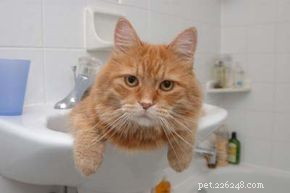
Except for removing a mat or performing a medical procedure, there is almost no other reason to shave a cat's hair. Cats are built to have a full coat of hair -- taking it away can throw off regulation of their body temperature and expose the usually protected skin underneath. Trimming a longhair cat's coat for appearances and to prevent tangles is fine, but it should be done by a professional groomer.
It's usually not necessary to bathe a cat, either, since they do so well keeping themselves clean. Sometimes, though, a bath is called for to treat or control fleas, to clean up an adventurous feline explorer, to treat a skin condition, or to remove a noxious or dangerous mess from your cat's fur. The squeamish, the inexperienced, and the uncertain should probably let a veterinarian or groomer take care of these mandatory baths. For those who want to try it at home, here are several bath basics.
Be prepared. Lay out your bathing supplies ahead of time. You'll need a good pet shampoo (get medicated shampoos for fleas or skin conditions from your vet, not over-the-counter); a large fluffy towel; a brush and comb; and either a handheld shower head or plastic tumbler for wetting and rinsing. It's a good idea to comb out your cat's hair before bathing, if possible, especially for longhairs. If you know how, now is the time to trim your cat's nails. (Note:You can protect your cat's eyes during a bath with a neutral ophthalmic ointment available from your veterinarian.)
Ready your bathing stations. Use a large sink with a dish sprayer attachment or the bathtub. Start the water before you put the cat in, and make sure it's not too hot or too cold. A comfortable temperature for your hands should work fine. You're going to get wet, splattered with suds, and possibly jumped on by an upset, sopping cat, so dress appropriately in clothes that can get soiled yet protect you from scratches.
Before you add the cat. Bathing a cat is often a two-person job -- one to restrain and one to bathe -- but you can do it yourself. Either way, practice restraint techniques on dry land before the bath. With one hand, grasp your cat firmly but gently at the base of the neck or on the scruff, pressing down slightly. See how well you can reach the various parts of your cat's body with the other hand. Figure out when and how you'll have to change grips during the bath. Get your bathing routine down step-by-step before the cat is in the tub or sink; otherwise, Tabby will be able to make a break for it in your moment of hesitation or confusion.
Start the suds. Wet down your cat, starting from the head and working your way to the tail. Apply the shampoo the same way, lather, and rinse thoroughly. (Read the label directions on medicated shampoos carefully. Some require 5 to 15 minutes before rinsing in order to be effective.) Thorough rinsing is important. Leftover soap residue can irritate your cat's skin or be swallowed when your cat licks her fur. Rinsing also gets rid of fleas and other parasites that are immobilized -- but not killed -- by the bath.
Drying a cat. Gently squeeze excess water out of your cat's fur, wrap her up in a large fluffy towel, and dry her off. If she'll stand for it, you can comb out any tangles right away; otherwise, wait until she's dried off and settled down. If you're lucky, your cat may tolerate the sound and feel of a blow dryer. Don't count on it, though -- many cats are terrified by them. This is not something to discover right after a bath. See how your cat reacts to the blow dryer on a non-bath day. If she's scared witless, stick with a towel. You might be able to gradually get her used to the sound and feel (especially if you begin regular baths in kittenhood) -- and then again, you might not!
A large part of keeping your cat healthy is removing potential dangers from your cat's environment. On the next page, we will show you how to cat-proof your home.
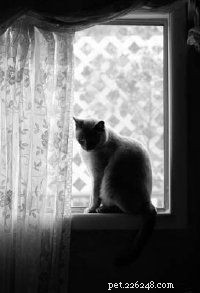
We all know to keep dangerous substances away from children, and it's important to remember that we should be even more careful with cats. We all know the old saying about what curiosity did to the cat. Because they are smaller, more mobile, and have more sensitive noses than children, cats are more likely to investigate, getting into things that can be dangerous. To prevent your cat's curiosity from becoming fatal, there are a few household dangers to look out for.
Drapery, blind, and electrical cords. To your cat's eye, the dangling end of a drapery or blind cord is an open invitation to play -- and possibly to disaster. Even just crawling between drapes or blinds and the window (an all-time favorite feline pastime) can land Tabby in a tangle. Cats who get caught in the loops of pull-cords panic. At the very least, the blinds or drapery rod will come down with a crash. At worst, a cat can strangle, do fatal internal damage, or actually get so worked up that his heart gives out. For maximum safety, tie or wrap all window cords well out of feline reach.
Electrical and telephone cords pose something of a tangling threat but more often are dangerous on account of chewing. It might be the taste or texture of the plastic coating, but for some reason, a lot of cats can't resist nibbling. There's not much direct danger in chewing phone cords (except when you try to make a call on a line that's been put out of commission by your cat) since there's very little current running through them.
Electrical cords are another story altogether, of course. Wherever possible, run the cords under rugs and carpets or behind furniture that sits flush to the floor and wall. If a cord has to be run where a cat can reach it, buy some inexpensive plastic conduit, which is available at most hardware and building supply stores. For a larger investment, you can get flat strips of heavy-duty vinyl that not only protect the electrical cords, but also keep the cords flush to the floor to prevent tripping.
Occasionally, a very determined cat will make his way through all the physical barriers. Treating the cords with a bad-tasting substance like bitter apple might do the trick. A little behavior modification, using positive reinforcement, will help, too.
Cleaning fluids, antifreeze, and other poisons. We don't just buy cleaners to get our house clean; we want it disinfected and smelling nice, too. Unfortunately, some of the very products we buy to sanitize and deodorize pet areas are outright dangerous for your cat.
Pine-based cleaners and those containing phenol (the most popular being Lysol disinfectant) are particularly toxic to cats and shouldn't be used on food bowls or in pet areas, sleeping quarters, or litter boxes. Of course, any cleaning compound can be poisonous if taken internally, so keep everything secured in a locking cabinet. (A simple spring latch won't keep a determinedly curious cat out.)
Ethylene glycol is the stuff that makes antifreeze work. It just so happens that it also smells and tastes very sweet. A significant number of cats and dogs -- and even small children -- suffer from ethylene glycol poisoning every winter. Because it's present in large amounts in almost every home and is often very fatal if swallowed, antifreeze and other products containing ethylene glycol should be considered dangerous and never left where pets or children can get to them.
Cats who go outdoors run the added risk of lapping up antifreeze spills and drips, an especially tempting thing for a thirsty cat to do since those puddles of tasty liquid don't freeze on cold days. You can protect your own cat (and other outdoor cats and strays) by immediately cleaning up and washing down any of your own spills or drips, or you can purchase one of the new nontoxic brands of antifreeze that contain propylene glycol rather than ethylene glycol. It's important to also keep in mind that once your cat leaves your property, there's no guarantee that everyone else in the area is going to be equally careful.
In general, anything that's toxic to you will be poisonous to your cat as well. The rule of thumb is:If you'd keep it out of reach of a child, keep it out of reach of your cat.
Poisonous plants. A cat chewing on your houseplants is more than an annoyance, it can be dangerous or even fatal to the cat.
Technically, any plant that makes your cat sick when eaten is a "poisonous" plant. (Nearly all cats will eat grass or plants to purge themselves, however, so vomiting alone may not be a reliable sign of poisoning.) Still, some plants have particularly serious effects. The list of potentially poisonous plants includes:apricot (pits), azalea, buttercup, caladium, calla lily, castorbean, cherry (twigs, leaves, bark, fruit, and stones), chrysanthemums, crocus, daffodil (bulbs), daphne (berries), holly, hydrangea, iris (leaves, roots, and fleshy parts), ivy, lily of the valley (leaves, flowers, roots), mistletoe (especially the berries), mushrooms, narcissus (bulbs), oak (acorns, young shoots, and leaves), oleander, peach (pits), philodendron, poison ivy, potatoes ("eyes" and sprouts from the eyes; the edible part of the potato is safe), privet, rhubarb (leaves), rosary pea (shiny red and black seeds), star of Bethlehem (bulb), string-of-pearls, sumac, and sweet pea (seeds and pods).
Dieffenbachia is a fairly common houseplant that also goes by the name of "dumb cane." The dumb cane is aptly named. Chewing dieffenbachia can actually paralyze your cat's mouth, making it impossible for him to eat and drink. The name "dumb cane" comes from the most noticeable effect of this paralysis on people:They can't talk.
Poinsettias (Christmas flowers) belong to the nightshade family -- flowers notorious in fact and literature for their deadly properties. A study a few years back seemed to show that poinsettias -- long believed to be dangerously toxic to cats and dogs -- don't make cats any sicker than many plants considered nonpoisonous. Still, it's always safest to keep cats away from any houseplant, just to be sure.
Windows, balconies, and screens. "High-rise syndrome" might sound like some sort of pop psychology explanation for violent crime, but it actually describes an epidemic that hits a number of cats every year, especially in warmer weather. "High-rise syndrome" is a collection of various injuries that are the result of a fall from a high window.
Amazingly, there are many stories of cats surviving falls from several flights up. But there are far more who fell and didn't make it. The saddest part of it is nearly all of those falls could have been prevented.
Every window that you plan to open needs to have a screen. And not just any screen. A cat-proof screen has to fit the window frame securely enough to stay firmly in place when confronted by ten or more pounds of cat. When ordering or replacing screens, use a heavy-duty grade of hardware cloth since ordinary screens can be easily torn by claws or teeth. Even a fall from a second- or third-story window can cause serious injury or death, so inspect all screens regularly, especially toward the end of winter in cold-weather areas of the country. Screens can warp, tear, or fatigue in the off-season.
Some city cat owners think letting Tabby out on the balcony of their apartment is a safe way to give him some fresh air and sunshine. Actually, a good number of "high-rise syndrome" cats were stalking moths, birds, or other irresistible things on an upper-floor balcony, when an ill-timed pounce or missed step sent them over the railing. Even a leash or tether on an open balcony doesn't ensure your cat's safety. A panicked cat dangling by his collar or harness can be strangled, seriously injured, or squirm loose and fall anyway.
Though you buy toys to amuse your cat, the wrong toy can be dangerous. In the next section, we will teach you what toys are safe for your cat.
The Animal Poison Control Hotline"My cat is a chowhound -- she never misses a meal," one cat owner recalls. "So when she didn't come running at dinnertime, I knew something was very wrong. I found her under the bed, and when I coaxed her out, she was staggering and drooling. I was terrified. She had this funny smell, which I recognized as the cleaning fluid I kept in my linen closet. I ran to the closet, and I found the door open and the can of cleaning fluid spilled on the floor.
"The problem is, we live a good 30 minutes from the nearest veterinarian. I didn't know how long she had been poisoned, and I wasn't sure that she had another half hour to spare. Then I remembered about the hotline -- and it saved my cat's life."
The ASPCA National Animal Poison Control Center (also called the Animal Poison Hotline) is operated by the University of Illinois College of Veterinary Medicine. Call 1 (888) 426-4435. There's a $55 flat fee, chargeable to a credit card (have your charge card ready). For more information, contact ASPCA Animal Poison Control Center (1717 South Philo Rd., Suite 36, Urbana, Illinois 61802).
Lees verder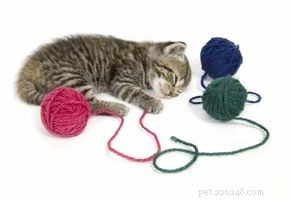
It's like something right out of a Norman Rockwell painting:a fuzzy little kitten tumbling around with a ball of yarn. Well, old Norman apparently never had to rush his cat to the vet for emergency surgery to get a couple of feet of that yarn unraveled from the poor cat's digestive tract. Yarn and string can turn even the most disinterested cats wide-eyed and playful but should never be left where cats or kittens can get at it on their own. Besides choking and intestinal blockage dangers, a cat who gets tangled up in string or yarn -- even during supervised play -- can panic and injure himself, possibly fatally. Take special care to keep sewing thread and dental floss out of feline reach; it's much finer and can become imbedded in the tissues of your cat's mouth, stomach, and intestines.
Cats will turn anything shiny, crinkly, or small enough to bat across the floor into a toy. Since Tabby doesn't have hands, he has to pick up these makeshift toys in his mouth, where they can be easily swallowed (or if not easily swallowed, can cause choking). At best, a foreign object in your cat's digestive system can trigger vomiting or diarrhea, but it can often be much worse. Keep things like paper clips, foil, and rubber bands safely tucked away.
Cellophane candy wrappers are particularly dangerous. Cats can't resist the crinkly texture, and the sugary residue makes them a cinch to get eaten. The wrappers can liquefy in your cat's stomach, coating the lining and blocking the uptake of nutrients from food.
What makes for a safe cat toy? Here's what to look for:
Something sturdy. If it can get tossed, thrown, gnawed, clawed, batted, kicked, licked, and repeatedly pounced on without coming apart, it's a good cat toy. Catnip-filled toys encourage play, but most cats like to eat catnip and will try to lick and chew their way to that scrumptious herbal filling. Catnip toys made from light fabric or felt will most likely be in shreds--and the shreds in your cat's tummy -- within a week. Ditto for plastic or vinyl toys that can be chewed up, cracked, or shattered.
No (re)movable parts. Catnip mice with yarn tails; crinkly cater- pillars with bug eyes; oversized plush "bumblebees" with glued-on felt features, and plastic mesh balls with tantalizing little bells inside are four of the more popular cat toys. But they share a common failing:small and potentially dangerous parts that come off. If you can pull or peel a part or decoration off a cat toy, the odds are your cat can, too. In fact, go ahead and try it with all your cat's toys -- it's better to have some catnip mice without tails than make a trip to the vet to get the tails out of your cat's stomach.
Something fun. A toy just isn't a toy if your cat won't play with it. Cat owners are often disappointed--and frequently annoyed -- to find that the $100 worth of custom cat toys they bring home get passed over for a piece of crumpled paper or a simple table tennis ball. Cats like games that involve what they do best:climbing, running, leaping, stalking, and pouncing. Pick toys that encourage those behaviors, and your cat is bound to use them. That's the allure of the table tennis ball -- it rolls and hops and skitters away when your cat pounces on it, encouraging batting and chasing. Cats see moving edges better than stationary objects, so toys that wiggle, bob, or weave fascinate them and trigger the stalking and hunting reflexes.
In our final section, we will cover perhaps the most important part of caring for you pet -- finding a good veterinarian. Finding a good vet for your cat is just as important as finding a good doctor for yourself.
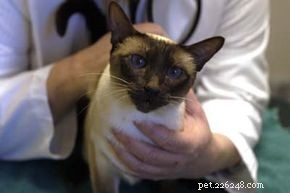
Choosing a veterinarian for your cat is a lot like choosing a doctor for yourself. You want someone with a good bedside manner and someone you like and trust. If you have special needs, you also want a doctor who understands and keeps those needs in mind.
If you're a first-time cat owner, have recently moved to a new area, or need to find a new veterinarian, you can just try opening the Yellow Pages to "Animal Hospitals." All veterinarians go to school as many years as medical doctors and have to meet strict standards for licensing, so you're bound to find a competent and professional vet that way. But the relationship among you, your pet, and your vet is going to last for many years, and if you took the time to find just the right cat, it makes sense to find the right vet. This might be the one area where city folk have it over country folk. A small town may just have one vet, while a big city has dozens within several miles.
Besides the Yellow Pages, here are some other sources for finding a good veterinarian:
Contact professional organizations. The American Veterinary Medical Association (www.avma.org) can refer you to affiliated veterinarians in your area, and the American Animal Hospital Association (www.aahanet.org) can direct you to clinics that meet its standards. The AVMA can also help you find feline specialists, behavior experts, veterinary eye doctors, and other professionals. Like any specialist, though, expect to pay heftier fees.
Get recommendations from other "cat people." Friends, family, and neighbors who have cats usually also have veterinarians. Take advantage of their experience, and get recommendations from them.
Once you get a referral for a veterinarian, call up, introduce yourself, and find out when you can drop by to see the facilities and meet the doctors. Make your visit brief but thorough. Be discriminating, but don't be put off if the vet and the clinic staff can't spend a long time with you -- they do have a hospital to run and patients to take care of. If you have a lot of questions and need the vet's undivided attention, the most polite thing to do is make an appointment -- and offer to pay for it.
If you are going to drop by the facility and meet with the vet, here are some items to consider:
Feline Vaccinations What exactly are vaccinations, and how do they help keep cats healthy? Here's how most vaccines work. Researchers find the germ causing the disease--for example, the virus that causes feline distemper. Next they produce a harmless, noncontagious version of the virus. This form of the virus is used to vaccinate healthy cats. The vaccine triggers the cat's disease-fighting immune system, which attacks and destroys the virus. This exposure "primes" the immune system so that if the same virus shows up again -- even the dangerous, contagious version -- it will be destroyed before it can cause illness.Vaccines protect your cat from common diseases, mostly caused by viruses. When a virus invades an animal's body, no medicine can kill it. You can give a cat with a virus things like antibiotics from now until doomsday, and it won't cure the disease (although the antibiotics will help treat or control infections that might start as a result of the cat's being sick with the virus). Viral diseases just have to run their course, after which the victim is often immune for life. Vaccines (usually with regular booster shots) provide your cat with the benefits of being immune without actually having to suffer through the disease.
Vaccines can't cure diseases caused by viruses. Going back to feline distemper for a moment, if a cat has already contracted this disease, the vaccine won't stop it. Vaccines also can't prevent every viral disease every time. No vaccine is 100 percent effective, so every once in awhile a cat who has all his shots will still get sick with something he's supposed to be protected against. Some diseases, like FIV, are caused by viruses that shut down the immune system when they first enter the cat's body. In those cases, the vaccine can't do its job because its tools (the disease-fighting system of the cat's body) have been taken away.
Get your cat's shots from a veterinarian or animal hospital. At the bare minimum, cats should be up-to-date on their rabies shot and distemper-combination vaccine. The combination shot usually carries protection against feline distemper (panleukopenia) and common upper respiratory diseases that cause cold- or flu-like symptoms in your cat (feline viral rhinotracheitis, calicivirus, and chlamydia). Vaccines may be given as an injection under the skin or in the muscle or as an aerosol administered directly into the cat's nostrils.
Any cat being vaccinated for the first time usually needs a series of shots, spaced several weeks apart. For kittens, these shots start at seven or eight weeks of age and continue until they are four months old. Rabies vaccines are given as one shot administered initially to a kitten over three months of age and to adults of any age. The American Association of Feline Practitioners recommends that subsequent boosters for many diseases (depending on the type of vaccine used) be given a year from the initial series and then every three years thereafter. Check with your veterinarian for vaccine scheduling recommendations for your cat.
Vaccines for other cat diseases have been around since the mid-1980s, particularly the one for feline leukemia virus (FeLV). FeLV (or FeLeuk, as it's sometimes known) attacks a cat's white blood cells and can produce a kind of cancer. Research shows that most cats exposed to FeLV don't get sick, but even infected cats who appear healthy can still pass the virus on to other cats. Once a cat does get sick from FeLV, though, the odds of recovery are poor.
The FeLV is a funny creature -- it doesn't last long outside of a cat's body, unless it stays a little moist. So the most common way FeLV gets passed is prolonged close contact between a healthy cat and infected cat -- things like mutual grooming, or sharing food, water, or litter boxes. This also means that the FeLV vaccine may not be necessary for a cat that is never exposed to FeLV-infected cats. A simple blood test can determine if your cat (or any new cat you're thinking of taking into your home) is infected. If not, keeping your FeLV-free cats indoors and away from FeLV-infected cats is probably all the protection they need (outdoor or indoor/outdoor cats are a different story). If your cat tests positive for FeLV, the vaccine won't help, either; vaccines don't kill the virus, they only protect uninfected cats from getting it.
Feline immunodeficiency virus (FIV) and feline infectious peritonitis (FIP) are also fatal cat diseases caused by viruses. There are laboratory tests for their detection, but the test used currently for FIP can give inconclusive results. Vaccines exist for FIV and FIP, but the jury is still out on their effectiveness in preventing disease transmission. Your veterinarian can help you figure out if your cat is at risk for these diseases and if the potential benefits of each vaccine outweigh the risks.
While you will face many challenges as a pet owner, you now know the basic care tips that every cat needs to be happy and healthy.
Publications International, Ltd.